"Cherishing Little Steps - A Haven for Baby and Family Journeys"
Standard Crib
Are you expecting a little bundle of joy?
Well, get ready to dive into the world of cribs! A standard crib is an absolute must-have for your baby’s safety and comfort.
In this article, we’ll guide you through everything you need to know about standard cribs – from different types and safety regulations to choosing the right one for your baby.
So, let’s jump in and make sure your little one has the best sleep ever!
Key Takeaways
- Standard cribs provide a safe and secure sleeping environment for babies.
- They promote healthy sleep habits for both babies and parents.
- Standard cribs have adjustable features and convertible options for versatility.
- Following safety regulations and tips is essential for ensuring the safety of the crib.
Importance of a Standard Crib
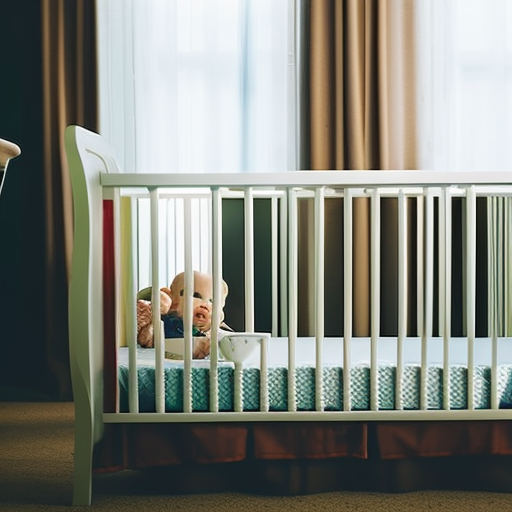
The importance of a standard crib is that it meets safety standards to protect your baby. A standard crib provides numerous benefits for both you and your little one.
Firstly, it ensures a safe sleeping environment for your baby by adhering to specific regulations set by safety organizations. These cribs are designed with sturdy materials and secure hardware to prevent accidents like entrapment or falls.
Secondly, a standard crib promotes healthy sleep habits for your baby. With proper mattress support and sufficient space, your little one can rest comfortably throughout the night, leading to better overall development and growth. Additionally, these cribs often come with adjustable mattress heights, allowing you to lower the mattress as your baby grows older and becomes more mobile. This feature prevents them from climbing out of the crib or accidentally falling over the rails.
Lastly, investing in a standard crib gives you peace of mind knowing that you have provided a safe and comfortable sleeping environment for your precious bundle of joy.
Types of Standard Cribs
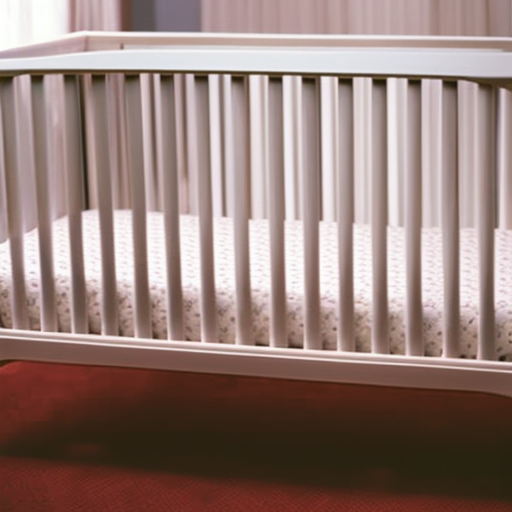
Check out the different types of cribs available for you! When it comes to choosing a standard crib, there are a few options to consider.
The most common type is the traditional crib, which features stationary sides and a mattress that can be adjusted to different heights as your baby grows.
Another popular option is the convertible crib, which can be transformed into a toddler bed or even a full-size bed as your child gets older.
If space is limited in your nursery, you might want to consider a mini crib. These cribs have the same functionality as standard cribs but are smaller in size, making them ideal for small rooms or apartments.
It’s important to note that standard crib dimensions will vary slightly depending on the manufacturer. However, most standard cribs have an interior dimension of approximately 28 inches by 52 inches. This ensures that they meet safety standards and provide enough space for your little one to sleep comfortably.
When choosing a crib, make sure to check if it meets all safety regulations and has proper certifications. Remember to always follow the manufacturer’s instructions for assembly and use, ensuring that your baby sleeps safely and soundly in their new crib.
Safety Regulations for Standard Cribs
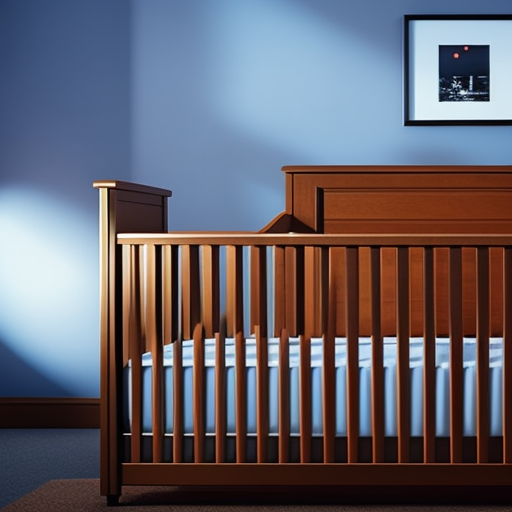
Make sure you’re aware of the safety regulations when choosing a crib for your baby. Ensuring that your little one’s sleeping environment is safe is essential for their well-being.
Here are some important safety requirements and industry standards to keep in mind:
-
Sturdy construction: Choose a crib made of durable materials like solid wood or metal, with no loose or wobbly parts.
-
Safe spacing: The distance between slats should be no more than 2⅜ inches to prevent your baby from getting stuck.
-
Mattress fit: Make sure the mattress fits snugly into the crib with no gaps larger than two fingers.
When it comes to safety, always prioritize cribs that meet industry standards such as those set by the Consumer Product Safety Commission (CPSC) and ASTM International. Look for certifications like JPMA (Juvenile Products Manufacturers Association) to ensure the crib has undergone rigorous testing.
Choosing the Right Standard Crib for Your Baby
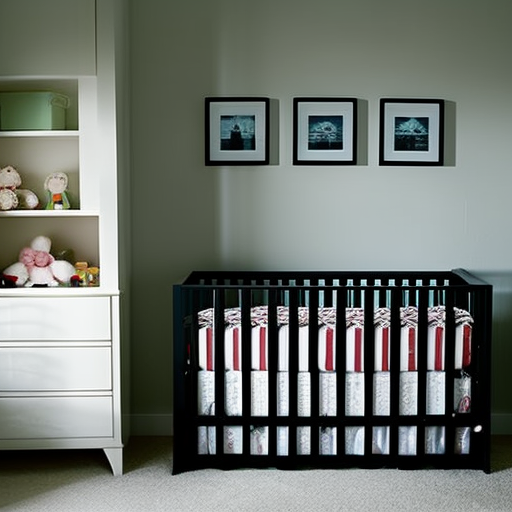
To choose the right crib for your baby, consider factors such as safety regulations and industry standards. Ensuring that your baby’s crib meets standard safety guidelines is crucial to their well-being. When selecting a standard crib, pay attention to features like slat spacing, mattress height adjustability, and sturdy construction.
Here is a table summarizing the key points to consider when choosing a standard crib:
| Feature | Importance | Description |
|---|---|---|
| Slats spacing | High | Should be no more than 2 3/8 inches apart to prevent head entrapment. |
| Mattress height | Medium | Adjustable mattress positions allow for easy access and safety as your baby grows. |
| Sturdy construction | High | A robust frame ensures stability and durability for long-term use. |
Remember that choosing a safe and comfortable mattress is equally important. Look for a standard crib mattress that fits snugly in the crib without any gaps around the edges. It should be firm enough to provide proper support and reduce the risk of suffocation.
Benefits of Using a Standard Crib
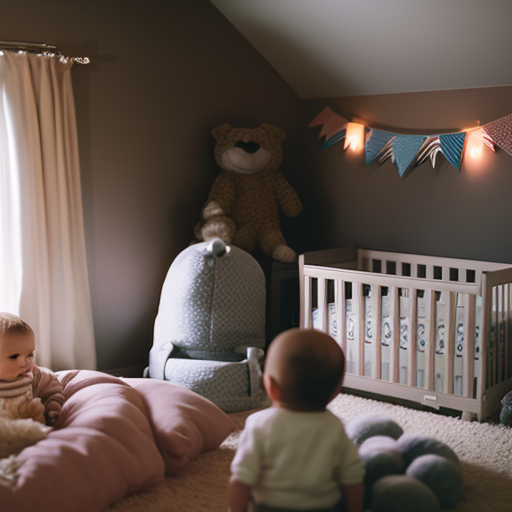
Using a standard crib offers numerous advantages for both parents and babies. Here are three key features that make it a great choice:
-
Safety: Standard cribs are designed with safety in mind, providing a secure sleeping environment for your baby. They often come with adjustable mattress heights, sturdy construction, and meet strict safety standards to minimize the risk of accidents.
-
Convenience: Having a standard crib allows you to have a dedicated space for your baby’s sleep routine. It provides a comfortable and familiar environment, making it easier for your little one to fall asleep and stay asleep throughout the night.
-
Versatility: Standard cribs often come with adjustable features such as mattress heights and convertible options that can grow with your child. This means you can use it from infancy through toddlerhood, saving you money in the long run.
In addition to these features, using a standard crib also promotes healthy sleep habits for both babies and parents. It creates boundaries and establishes a bedtime routine, which contributes to better sleep quality overall.
Investing in a standard crib is not only beneficial for your baby’s well-being but also provides peace of mind for parents knowing their little one is safe and comfortable during sleep time.
Tips for Setting Up a Standard Crib
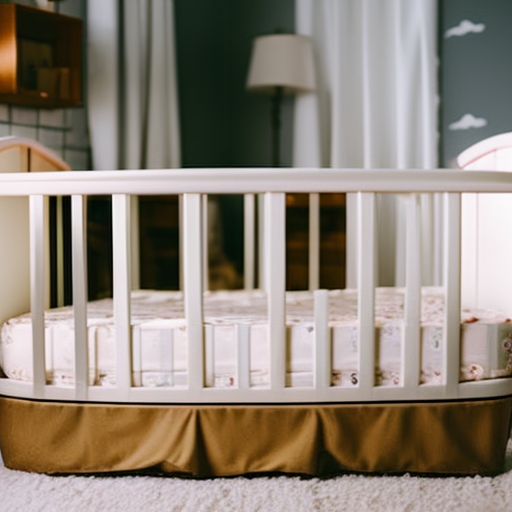
Now that you understand the benefits of using a standard crib, let’s talk about some tips for setting it up safely. Ensuring a safe sleeping environment for your little one is crucial, and proper setup of the crib plays a significant role in this.
To help you get started, here are some safety tips for setting up a standard crib:
| Safety Tips | Explanation |
|---|---|
| Choose the right location | Place the crib away from windows, blinds, cords, and any other potential hazards. |
| Assemble according to instructions | Follow the manufacturer’s instructions carefully to ensure correct assembly. Double-check that all screws and bolts are tightly secured. |
| Use a firm mattress | Opt for a firm mattress that fits snugly into the crib without any gaps. Avoid soft bedding like pillows or blankets as they can increase the risk of suffocation. |
| Keep an eye on height adjustments | If your crib has adjustable mattress heights, make sure to lower it as your baby grows to prevent climbing accidents. |
Maintenance and Cleaning of a Standard Crib
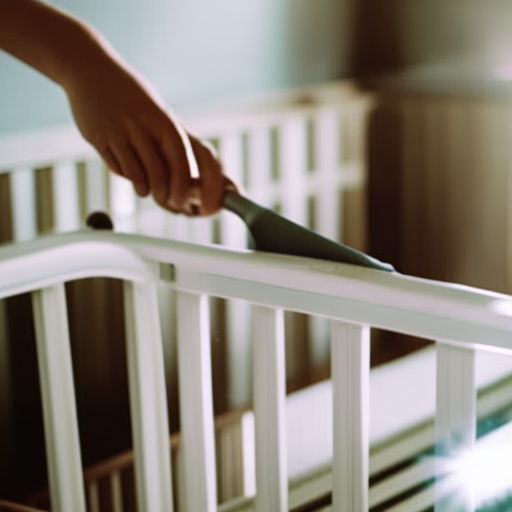
Regularly cleaning and maintaining your baby’s crib is essential for ensuring a safe and hygienic sleeping environment. Here are some maintenance tips and recommended cleaning products to keep in mind:
-
Inspect the crib regularly: Check for any loose screws or broken parts that could pose a safety hazard. Tighten any loose screws and replace any damaged parts immediately.
-
Clean the crib mattress: Start by removing all bedding and vacuuming the mattress to remove dust and dirt. Use a mild detergent mixed with warm water to spot clean any stains on the mattress surface. Allow it to air dry thoroughly before putting fresh bedding back on.
-
Wipe down the crib frame: Use a damp cloth with mild soap or baby-safe disinfectant wipes to wipe down the entire crib frame, including the bars, corners, and sides. Pay special attention to areas where dribbles or spills may accumulate.
When it comes to cleaning products, opt for non-toxic options that are safe for babies such as baby-safe detergents, mild soaps, and natural disinfectants. Avoid using harsh chemicals or strong fragrances that could irritate your baby’s sensitive skin or respiratory system.
Standard Crib Accessories and Bedding
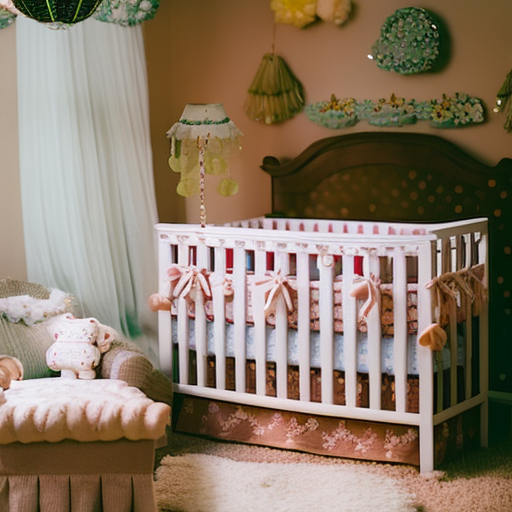
To make the crib more comfortable for your baby, consider adding accessories and bedding such as a soft mattress pad and cozy blankets. These standard crib accessories can help create a soothing environment for your little one to sleep and relax in.
When it comes to standard crib bedding, there are a few key items to consider. A fitted sheet is essential for covering the mattress and providing a smooth surface for your baby to lie on. Look for sheets made of soft, breathable materials like cotton or bamboo.
Another important accessory is a mattress pad. This thin layer of padding adds extra comfort and protection to the crib mattress. It can help prevent stains, odors, and allergens from seeping into the mattress while also providing an additional level of cushioning.
Cozy blankets are also great additions to your baby’s crib. Opt for ones made of lightweight materials that won’t overheat your little one during sleep. Swaddle blankets are especially useful for newborns as they provide a snug feeling reminiscent of being in the womb.
Remember to regularly wash all bedding and accessories according to manufacturer instructions to keep them clean and hygienic for your baby’s safety.
Transitioning From a Standard Crib to a Toddler Bed
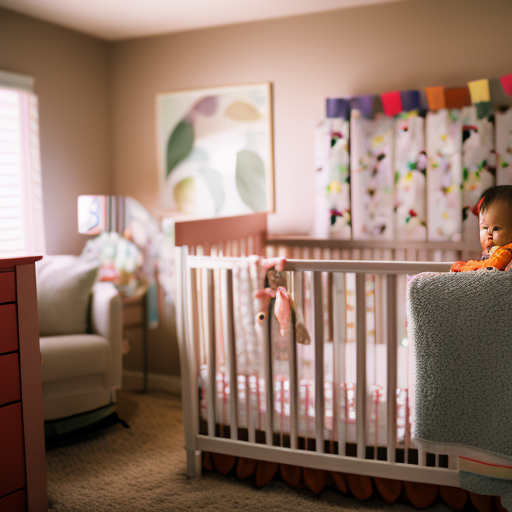
When you’re ready to transition, consider moving your toddler from the crib to a toddler bed for a more independent sleep experience. Transitioning can be an exciting milestone for both you and your little one. Here are some transitioning tips and insights into toddler sleep habits to help make the process smoother:
-
Timing: Wait until your child is physically ready, usually around 18 months to 3 years old. Look for signs like climbing out of the crib or expressing interest in a big kid bed.
-
Preparation: Involve your child in choosing their new bed and let them decorate it with their favorite bedding or stuffed animals. This will create excitement and ownership over their new sleeping space.
-
Consistency: Keep bedtime routines consistent during the transition. Stick to established rituals like reading a story or singing a lullaby before tucking them in.
Budget-Friendly Options for a Standard Crib
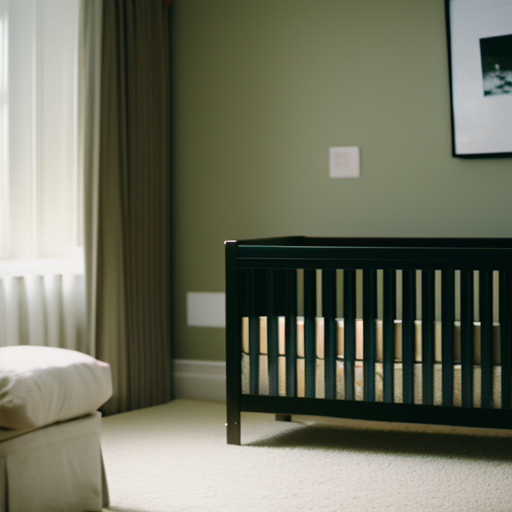
Looking for a budget-friendly option? Consider checking out secondhand options or exploring sales for affordable choices. When it comes to standard cribs, there are plenty of budget-friendly options available that can provide a safe and comfortable sleeping space for your little one without breaking the bank.
One way to save money on a standard crib is by opting for secondhand options. Many parents sell their gently used cribs at lower prices, allowing you to get a quality crib at a fraction of the cost. Just make sure to thoroughly inspect the crib for any damage or wear before making your purchase.
Another option is to keep an eye out for sales and discounts. Many retailers offer special promotions on baby furniture throughout the year, so be sure to take advantage of these opportunities. You might find great deals on cribs with space-saving designs, which can be especially beneficial if you have limited nursery space.
When looking for budget-friendly standard cribs, it’s important to prioritize safety and durability. Make sure that the crib meets all safety standards and has sturdy construction. Additionally, consider features such as adjustable mattress heights and convertible designs that can grow with your child, saving you money in the long run.
With some research and patience, you can find excellent budget-friendly options for standard cribs that will provide a cozy and secure sleeping environment for your little one while also fitting within your financial constraints.
Frequently Asked Questions
How Do I Assemble a Standard Crib?
To assemble a standard crib, follow the assembling instructions provided by the manufacturer. Ensure you take safety precautions, such as securing all screws tightly and ensuring the mattress fits snugly.
Can I Use a Standard Crib for Multiple Children?
You can use a standard crib for multiple children, but there are pros and cons to consider. It’s convenient and cost-effective, but you may need to replace worn-out parts or consider safety concerns as the crib ages.
Are Standard Cribs Suitable for Small Spaces?
Yes, standard cribs can be suitable for small spaces. They offer a secure sleeping space for your child while still fitting into tight areas. If space is a concern, alternative sleeping options like bassinets or mini cribs may also be considered.
What Should I Do if My Baby Keeps Climbing Out of the Standard Crib?
If your baby keeps climbing out of the standard crib, it’s time to take action. Start by babyproofing the room and removing any hazards. Consider transitioning to a toddler bed for their safety and your peace of mind.
Are There Any Special Considerations for Using a Standard Crib With Twins or Multiples?
When using a standard crib with twins or multiples, it’s important to consider safety concerns. Make sure the crib meets all safety standards and avoid placing any objects that could pose a suffocation risk.
Conclusion
In conclusion, choosing a standard crib for your baby is a decision that should not be taken lightly. It provides a safe and comfortable sleeping environment while adhering to important safety regulations.
Just like a lighthouse guides ships safely to shore, a standard crib serves as a beacon of protection for your little one.
With proper maintenance and cleaning, along with the right accessories and bedding, you can create an inviting and cozy space for your baby to rest and grow.
So invest in a standard crib today and watch as it becomes the anchor of sweet dreams for your child.


